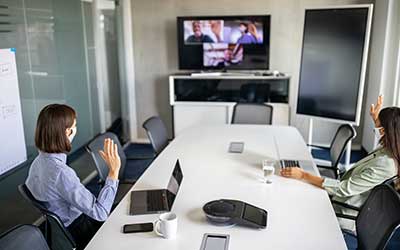Thank You!
Thank You For Contacting Us!
Your message has been successfully received. We will be in touch with you shortly.
Blogs
-
Friday, April 12, 2024
HOW BALTIMORE’S FRANCIS SCOTT KEY BRIDGE COLLAPSE AFFECTS RELOCATION
-
Wednesday, April 3, 2024
Developing Inclusion and Belonging to Enhance the Mobility Experience
-
Tuesday, April 2, 2024
Why Waiting for Lower Mortgage Rates Might Not Be Best for Relocating Employees
-
Tuesday, March 26, 2024
Conversations With Mobility Leaders: How ESG Macro-Trends Influence Mobility Strategies
COVID-19 Remobilization Considerations: Setbacks and Second Waves
As organizations strategize and plan for remobilization, it will be critical to anticipate and prepare for setbacks and challenges, as additional COVID-19 case surges may stall goals and intended mobility-related activities. The content below will explore possible scenarios and strategies that organizations can consider when preparing for unknown remobilization barriers.
The Current State of Mobility Readiness
Organizations have been monitoring ‘mobility readiness’ in their global operating locations, particularly in locations that are considered critical for organizational success. Based on our conversations with clients, many organizations are anxiously awaiting the lifting of mobilization restrictions and, in turn, an easing of the business pressures caused by resulting talent shortages and an inability to meet business needs and priorities. Some businesses are focused on the repatriation of employees to their home locations. Other organizations are focusing on longer-term workforce planning to minimize the need to import talent, thereby reducing the impact of a future global crisis or disaster. Regardless of the driver, the remobilization process will be location specific, and organizations should be prepared to navigate additional pandemic waves as part of their remobilization strategy.
Signs of Potential Surges and Setbacks

As organizations monitor locations and evaluate them for remobilization readiness, they will also need to consider indicators that point to potential surges and setbacks. These include:
- An increase in confirmed cases of COVID-19
- An increase in the number of COVID-19-related deaths
- Changes in country and/or local restrictions: quarantine requirements, social distancing, curfews, mask requirements, etc.
- Changes in travel requirements or travel restrictions (e.g., inability to travel to/from a particular location, or quarantine requirements when traveling to/from a particular location
- Changes in immigration requirements
Any of the above challenges could indicate the potential for, or confirmation of, a setback or second wave, which may have an impact on planned remobilization activities. Mobility teams, in partnership with key stakeholders, should be prepared to implement crisis and disaster management protocols and business contingency plans quickly. Utilizing SIRVA’s COVID-19 Reopening Matrix will be extremely helpful, as it includes current information on over 40 countries regarding such topics as household goods (HHG) norms, visa and immigration updates, business travel restrictions, and more. The topics are broken down, per country, for ease of use and quick reference.
Potential Impact of Setbacks
Setbacks due to additional COVID-19 surges may have the following impacts on remobilization and new deployment initiatives that may have been planned:
- Revised remobilization/deployment timelines
- A temporary halt or modification of relocation services
- Increased or unplanned mobility program costs
- Increased relocation budgets for continuing or new deployments, due to additional needs and extended support requirements
- The need for urgent travel: booking services, immigration support, or SOS services
- The need for urgent support: travel, temporary housing, living expenses, immigration, storage, etc.
- An increase in exception requests
- An inability to meet organizational goals resulting from talent/resource shortages as a result of a company’s inability to deploy resources
- Re-evaluation of critical relocations
Impact-minimization strategies may need to be fluid and agile depending on organizational goals, cost tolerance, employee preferences, and health and safety concerns.
Looking Back: Lessons Learned and Course Corrections
 For most organizations, the COVID-19 pandemic has been the most significant crisis to ever impact their business. It will be important to learn from this experience and improve on the implementation of existing response strategies; to accomplish this, mobility teams are encouraged to review their COVID-19 response effectiveness to date, evaluate what worked well, and identify where improvements or efficiencies may have yielded more favorable results. Key questions to consider include:
For most organizations, the COVID-19 pandemic has been the most significant crisis to ever impact their business. It will be important to learn from this experience and improve on the implementation of existing response strategies; to accomplish this, mobility teams are encouraged to review their COVID-19 response effectiveness to date, evaluate what worked well, and identify where improvements or efficiencies may have yielded more favorable results. Key questions to consider include:
- Were employees and stakeholders engaged proactively and in a timely way?
- Was complete employee demographic data readily available to enable the response strategy?
- What improvements can be made to improve response time?
- Did the response strategy have financial impacts that could have been avoided or minimized?
- Were employees provided with the right kind, scope, and level of support to minimize impact and challenges?
- What changes can be implemented to better control unexpected costs?
- What feedback was received from employees and stakeholders regarding their experiences?
- Did existing (or modified) mobility and organizational policies help or hinder the response strategy?
- Were all mobility partners that are charged with facilitating processes (both internal and external) engaged in driving success?
- How can these partners be better engaged in the future to improve the response strategy?
- What programs and/or resources can be provided to better prepare employees and stakeholders for a future crisis or disaster?
- What are employee and stakeholder perspectives regarding the value of the support provided to them? What gaps were identified? Did the communication strategy for employees and stakeholders meet expectations? What improvements can be introduced to minimize gaps?
- Did supplier partners react swiftly to organizational needs?
- What are the top five (5) improvement opportunities that have been identified?
Answers to the above questions can assist decision makers in understanding the successes and shortfalls of the company’s response strategy to COVID-19-related impacts, to date, and help to drive a more efficient response – not just to pandemic-related surges but also to other crises or disasters that may occur in the future. Now is the ideal time for mobility teams to evaluate and utilize this information.
Be Ready for Action
When setbacks or additional waves of COVID-10 are encountered, it will be important for mobility teams to move into crisis-/disaster-management response quickly, considering the lessons they learned earlier this year. Using the information that was gathered in response to the above questions, mobility leaders can prepare now by improving and implementing policies and procedures to address:
- Timely and ongoing communications to employees and stakeholders
- Communications and procedures that allow for mobility teams and partners to shift from remobilization activities to crisis and disaster management – or a combination of both, dependent on impacted employees
- Better and quicker access to real-time information
- A process that provides access to additional support
- Timely issue resolution and exception processing
Mobility teams have an opportunity to provide significant value-add services to their organizations by demonstrating the proactive application of lessons learned and enhancing the level of support available to employees and stakeholders when managing a crisis or disaster. Retrospective due diligence and response evaluation should facilitate the implementation of an improved response strategy that is ready to be applied, as needed.
Crisis and Disaster Familiarity

Some companies may find that subsequent surges of pandemic concerns will create the need for the repetition of impact-minimization activities. Organizations can review SIRVA’s Playbook for Mobility Management During Crises and Disasters for insights and guidance that may help them to prepare for effective responses. Subsequent response strategies may mirror those that were used during earlier stages of the pandemic but, for maximum impact, companies will benefit from asking themselves the questions mentioned in the Looking Back section above and identifying opportunities for improvement. New response strategies should recognize that:
- Organizations are applying lessons learned and support subsequent pandemic waves differently
- Organizations have less tolerance for additional mobility costs
- Organizations are now differentiating between critical relocations and relocations that are meant for developmental purposes or to fill immediate resource gaps
What Does the Future Look Like?
COVID-19 will continue to be a challenge for mobility programs and workforce planning initiatives for the near future. There is a likelihood of some level of continuing or renewed remobilization delays. Some setbacks may disrupt workforce deployment temporarily, while others may have a longer-term impact on the ability of an organization to meet strategic and talent priorities. Situations will be fluid; Mobility teams, stakeholders, and partners will need to be prepared to move quickly and to adapt support quickly as decisions are made. The landscape may require that this process be repeated a number of times until the virus can be contained and the global landscape is stabilized. However, with the previous knowledge organizations have gained and applied, businesses can be better prepared to pivot and implement effective response strategies, as necessary.
Contributors:
Elaine Baker
Senior Vice President, Sales & Account Management Global Support
LisaMarie DeSanto
Content Marketing Manager
- Global Mobility
- Program Optimization & Efficiency
- Americas
- Asia-Pacific
- Europe | Middle East | Africa
 COVID-19 Remobilization Considerations- Setbacks and Second Waves
COVID-19 Remobilization Considerations- Setbacks and Second Waves

